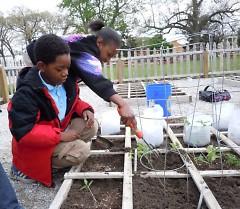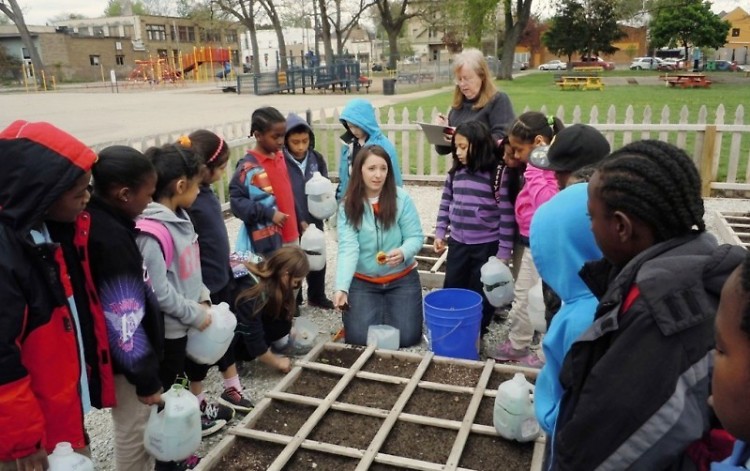
Third graders check out a rattlesnake bean seedling. The students got to pick their own heirloom varieties. /Feeding America West Michigan

D’Mikol, left, and a classmate plant green beans at Congress Elementary School. /Feeding America West Michigan
This dispatch was added by one of our Nonprofit Neighbors. It does not represent the editorial voice of The Rapidian or Community Media Center.

Renee Howard shows her third graders how to plant vegetables at the Congress Elementary School garden. /Feeding America West Michigan

Third graders check out a rattlesnake bean seedling. The students got to pick their own heirloom varieties. /Feeding America West Michigan

D’Mikol, left, and a classmate plant green beans at Congress Elementary School. /Feeding America West Michigan
Feeding America West Michigan Food Bank works with a network of 1,200 hunger-relief agencies across West Michigan and the Upper Peninsula. Many of those agencies and host sites do more than simply hand out food. Congress Elementary School in Grand Rapids is one of them.
On a May afternoon at Congress Elementary School in Grand Rapids, third grader Jadyn held up a plastic milk jug with a little green plant growing inside: a Brussels sprout. She’d picked the seeds out herself.
Why? “’Cause I love them,” she said.
At home, pan-fried Brussels sprouts are one of her favorite meals. “I like the crispy parts,” she said, “the burnt parts.”
Teacher Renee Howard and volunteer Kate Shockey brought the class of two dozen third graders out to the schoolyard garden to plant the flowers and vegetables they had been growing indoors all semester, everything from rattlesnake beans to sunflowers.
“We figured it’s better for them to be in the whole process and choose what they wanted to grow,” said Shockey, a lifelong gardener and a member of the East Hills Council of Neighbors, which partnered with Congress to create the garden last spring.
Congress is a diverse school with Black, White, and Hispanic students in roughly equal numbers. The poverty rate is high. Before the district extended free and reduced-price school meals to all students in 2012, 99 percent of students met the income requirements, according to Principal Bridget Cheney.
To keep students fed over the summer, Congress works with Feeding America West Michigan and St. Thomas the Apostle Parish to host a monthly Mobile Food Pantry. This year, distributions are scheduled for June, July and August. While the Mobile Pantries meet a short-term need for food, the school garden is a way of addressing food insecurity long term, cultivating a love of healthy foods and the knowledge of how to grow them.
“What we’ve been trying to impart to them is you don’t have to have a gigantic yard in a suburban or rural area,” Cheney said. “This can happen anywhere.”
The positive response from parents has been overwhelming, Cheney said, with parents and neighbors signing up to care for the plots over the summer.
On planting day, Howard reviewed concepts discussed in the classroom, like soil nutrients, decomposition and which parts of which plants are edible. Getting kids excited about vegetables seemed surprisingly easy.
D’Mikol, a third grader in a red jacket who has grown up gardening with his mom and grandma, said he loves green beans, especially as a side dish with steak.
“I’ve liked ’em since I was four,” he said. “I think everybody should have at least two servings of vegetables per day because you can get nice and strong.”
In a time when poverty pushes many families toward cheap, processed foods and away from fruits and vegetables, the Congress Elementary garden is a glimpse into a different future.
“If you want to change a mindset, one of the best ways to do it is through children,” Cheney said.
“Yes, there’s definitely a hunger issue, no doubt about it, but the nice thing is, we saw this as an obstacle and now we’re doing something about it.”
The Rapidian, a program of the 501(c)3 nonprofit Community Media Center, relies on the community’s support to help cover the cost of training reporters and publishing content.
We need your help.
If each of our readers and content creators who values this community platform help support its creation and maintenance, The Rapidian can continue to educate and facilitate a conversation around issues for years to come.
Please support The Rapidian and make a contribution today.